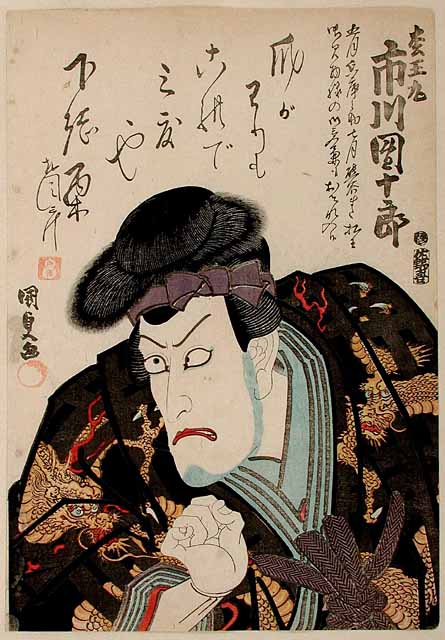
This print was issued commercially in the autumn of 1831. It is laden with visual and textual information for the viewer to process. The following notes indicate some of the ways in which this print would have been read when first offered for sale.
Inscriptions and marks
- The largest characters inscribed at the top right of the print name the actor depicted: Ichikawa Danjuro VII, one of the great exponents of heroic roles and the most popular of all nineteenth-century actors.* To the right of his name in much smaller characters is the name of the role in which he is depicted: that of Matsuomaru, one of the heroes in the popular historical drama Sugawara and the Secrets of Calligraphy. He performed the role in a revival of the drama that opened at the Kawarazaki Theatre in Edo in 09.1831.
- The two lines of cursive script to the left of the actors name remind the viewer of two other heroic roles that Danjuro had performed that season: Hyogonosuke in Yaguchi Ferry Crossing and Kumagae Naozane in Chronicle of the Battle of Ichinotani in performances at the Kawarazaki Theatre in the fifth and seventh month of 1831 respectively.
- The artists signature, Kunisada ga (drawn by Kunisada), appears on the left edge of the print, written in characters of modest size and followed by the red circular toshidama seal used by artists of the Utagawa school.
- The signature is balanced on the right edge of the print by the censors seal and publishers mark, which are placed just below Danjuros name. The publisher Sanoya Kihei issued many of Kunisadas actor prints in the late 1820s and the 1830s.
- Above Danjuros head there is a poem of his own composition printed from a block that reproduces his own cursive script. It is signed and sealed the seventh generation Sansho (Sansho is the poetry name used by bearers of the Danjuro stage name.) The poem with its dense word play and multiple levels of meaning would have teased and delighted Danjuros fans, many of whom would also have been amateur poets. Only a few of the puns and allusions can be hinted at here.
Migawari mo
kore de sando ya
Shimosa guriHere I am, for the third time,
with a changed appearance,
- The place, Shimosa, in the last line of the poem is the name of the province in which the first actor to bear the Danjuro name was born in the seventeenth century. His successors made pilgrimages to his birthplace there to honour his memory.
- The phrase Shimosa guri (Chestnuts from Shimosa) asks the reader to compare the fuzzy-haired appearance of Danjuro as depicted here with a bristly chestnut from Shimosa.
- There is also a verbal pun in sando (third time) and guri (chestnut): Sando guri is a type of chestnut that bears fruit three times a year.
- Sando (third time) appears in the phrase for a third time/with a changed appearance. This refers to the three roles that Danjuro performed that season, all of which are named on the print.
Image
- Make-up and costume indicate that Danjuro is shown in a scene in the fourth act of the play entitled The Village Schoolroom (Terakoya).
- Matsuomaru makes his entrance in this scene in a palanquin feigning illness. His unshaved forehead, unruly hair and purple headband tied on the left side of his head to bring relief from headache, all lend credence to his claim that he is ill and at the same time indicate to the viewer that he is in a state of extreme nervous tension.* On stage, the costume worn by Danjuro VII in this scene would have been decorated with the branches of a snow-laden pine.
The snow-covered pine branches (matsu) were meant not only to recall the characters name, _Matsuo_maru, but alsothrough their literary associationsto emphasise his tragic fate and heroic nature (his triplet brothers were named after the plum, _Umeo_maru, and cherry, _Sakura_maru). In this print, Kunisada chose to depart from stage convention and depict the hero in a heavy overcoat decorated with roused dragons, beasts associated with great strength and nobility. The dragons serve to amplify the force of Danjuros VIIs pose and reflect the dreadful conflict of emotions within his loyal heart.
Although he is in the employ of the villain of the piece, Matsuomaru remains loyal to his true lord, Kan Shojo. The villain ordered the murder of Kan Shojos young son and heir, Kan Shusai. He commanded Matsuomaro to accompany the party of officers sent to capture and kill the boy because he was the only person in his retinue who could identify the boy with certainty. Matsuomaru contrived to have his own son killed in place of Kan Shusai. His son is murdered off stage; it takes all his will to retain his composure at the muffled sound of the deathblow. His sons severed head is then brought on stage in a box and laid before him. He opens the box, gazes on his sons head, and with complete self-control announces, Ah, that he has beheaded Kan Shusai.there can be no doubt, no question.
Kunisada has depicted Danjuro as Matsuomaru at this dreadful moment. We see the actor portraying Matsuomarus pain as he is caught between his personal, paternal feelings and the merciless demands made by the code of loyalty that bound him to his lord. His excruciating inner struggle is expressed by the way the actor clenches his fist, grits his teeth and crosses his eyes. The hero must, without hesitation, fulfil his obligations to his lord no matter what the personal cost. This grim scene is regarded as one of the weightiest in all Kabuki for male-role actors.
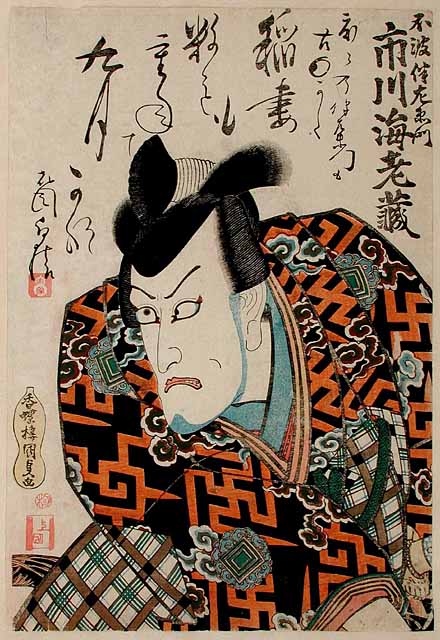
Ichikawa Ebizo V (formerly Danjuro VII) as Fuwa Banzaemon (right) and Onoe Kikugoro III as Nagoya Sanza (left) in Nagoya obi kumo ni inazuma (A Nagoya rope sash and robes with lightning bolts amidst clouds) performed at the Morita Theatre in 09/1836
Private collection
This pair of portraits commemorates a revival (with a different name) of the play that brought Danjuro VII (now acting as Ebizo V) and Kikugoro III together in these highly successful roles. The well-known rivalry between the two actors added spice to their confrontation in this famous ‘Scabbards clashing’ (Saya-ate) scene in the third act, which had featured in prints associated with earlier productions. Fuwa Banzaemon carries a sword named ‘Thunder’ and wears a kimono decorated with a pattern of ‘lightning-in-the-clouds’.
His rival Nagoya Sanza carries a sword named ‘Amorous Swallows’ and wears a kimono with a ‘swallows-in-the-rain’ pattern tied with a sash of knitted rope. Unaware of each other, they make simultaneous entrances boasting of their fame, along the two raised passageways (hanamichi) that run through the audience to the main stage. As they pass on the main stage, which represents Nakano Street in the Yoshiwara pleasure district at cherry blossom time, their sword hilts clash. They exchange insults, remove their green sedge travelling-hats, recognize one another and draw swords to fight over the courtesan Katsuragi, whom they both love.
Above the actors’ heads are hokku poems (haiku) written by the actors themselves. Danjuro’s poem is signed with his poetry name Hakuen. It alludes to his repeated appearances in this role and to the lightning-in-the-clouds pattern on his robe, as well as to the date of this performance in the ninth month.
Bolts of lightning Inazuma mo appear countless times kazu o kasanete in the ninth month! kugatsu kana.
Kikugoro’s poem is signed with his poetry name Baiko. As well as alluding to the swallows-in the-rain pattern on his robes, the poem suggests a comparison between the action in this scene when the actors pass each other on stage, and geese and swallows flying past each other as one arrives and the other departs in the autumn, the season of this performance:
Passing by each other Yuki-chigau wild geese and swallows kari ni tsubame ya over ripened pampas grass. hanasusuki.
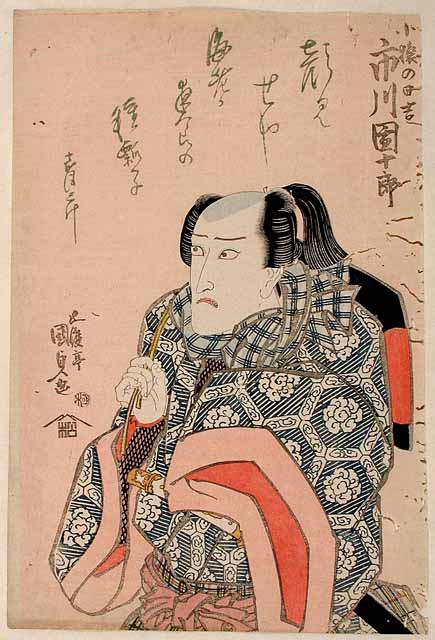
Ichikawa Danjuro VII as Kozaru no Hiyoshi in Saruwaka hisago no gumbai (Saruwaka’s gourd-crested battle fan) performed at the Nakamura Theatre in 11/1820 Kunisada 18
Private collection
From an untitled set of half-length portraits on a pink ground, linked to the same performance.
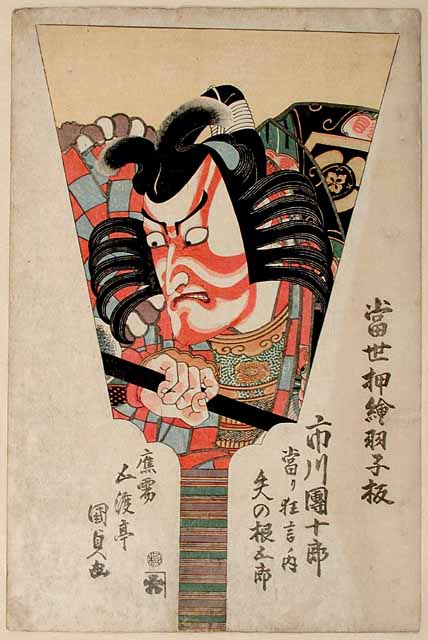
Ichikawa Danjuro VII as Soga no Goro c. 1823 Kunisada 22 Private collection
From the set of nine designs entitled Tosei oshi-e hagoita atari kyogen no uchii (Modern cloth-picture battledores stage hits). Danjuro VII is depicted as Soga no Goro in Yanone (The arrow-sharpener), one of the popular plays based on the story of the revenge of the Soga brothers on their father’s murderer, Suketsune. This virtuoso role was performed in the most extravagant ‘rough stuff’ (aragoto) style of acting developed by the Danjuro lineage of actors.
It allowed Danjuro VII to display his mastery in the portrayal of swash-buckling heroes. The striking face-paint, which is typical of such heroic roles, expresses the intensity of the character’s feelings. In this instance the hero, burning with rage, sharpens a double-tipped arrow with which he and his brother intend to avenge their father’s murder.
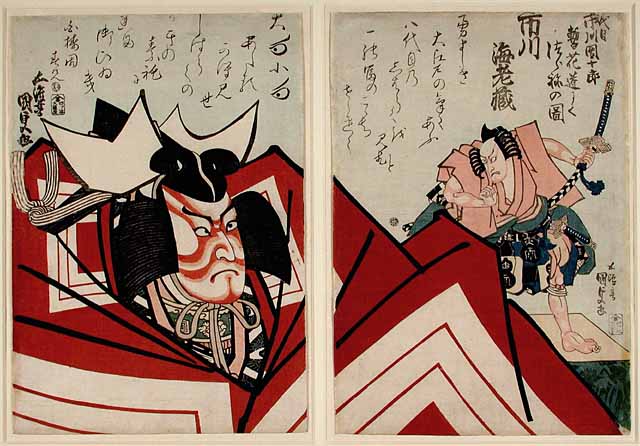
Ichikawa Danjuro VIII as Kamakura Gongoro in Shibaraku! (Stop Right There!) with Ichikawa Ebizo V (formerly Danjuro VII) in the background as the villain Narita Goro.
Kunisada 5
c.1836
Private collection
This diptych commemorates the debut of Danjuro VII’s eldest son in the central role of this play. The role is one of the great examples of the ‘rough-stuff’ style (aragoto) for which the Ichikawa line of actors was famous. Danjuro VIII is striking a defiant pose on the raised passageway (hanamichi) leading from the back of the theatre through the audience to the main stage, while his father, playing the role of the villain, looks on from the main stage.
This is the great moment when Narita Goro, on the point of executing the innocent Yoshitsuna and his fiance, is halted by the powerful voice of Gongoro coming from the rear of the theatre shouting ‘Shibaraku! Shibaraku!’ (‘Stop right there!’). The hero then strides onto the hanamichi wearing the most extravagant aragoto costume: a voluminous suo (‘plain sliding-door’) robe, with the Danjuro mon adorning square sleeves so wide that they have to be supported with splints. Laudatory poems fill the space above the figures. This impression, the only known surviving example of this diptych, has faded: the thick cord around Danjuro VIII’s neck was originally bright red, and the thin cord was purple.
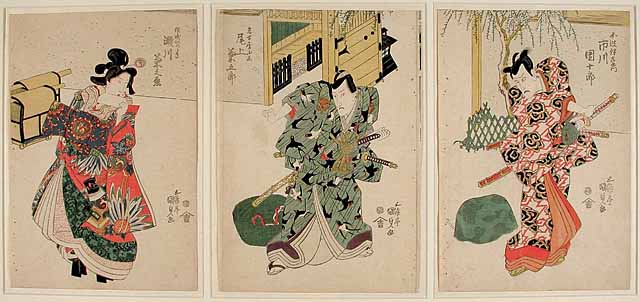
Ichikawa Danjuro VII as Fuwa Banzaemon (right), Onoe Kikugoro III as Nagoya Sanza (centre) and Segawa Kikunojo V as the courtesan Katsuragi (left) in Ukiyo-zuka hiyoku no inazuma (Ukiyo’s sword hilt, a double grave mound and the mark of the lightning bolt) performed at the Ichimura theatre in 03/1823
Kunisada 2
Private collection
This famous Saya-ate (‘Scabbards clashing’) confrontation scene occurs in the third act of the play, which was written for these performers and first performed in this production in 1823. The idea derived both from the established Kabuki convention of a Saya-ate scene, and from the 1807 novel by Santo Kyoden, Mukashi banashi inazuma hyoshi (An Old Time Lightning Bolt Tale). Fuwa Banzaemon carries a sword named ‘Thunder’ and wears a kimono decorated with a pattern of ‘lightning-in-the-clouds’. His rival Nagoya Sanzaburo (Sanza for short) carries a sword named ‘Amorous Swallows’ and wears a kimono decorated with a ‘swallows-in-the-rain’ pattern. Unaware of each other, they make simultaneous entrances along the two raised passageways (hanamichi) through the audience. As they pass on the main stage (which represents Nakano Street in the Yoshiwara pleasure district at cherry blossom time), their sword hilts clash. They exchange insults, remove their green sedge travelling-hats, recognize one another and draw swords to fight over the courtesan Katsuragi. Katsuragi rushes forward and persuades them to call a truce.
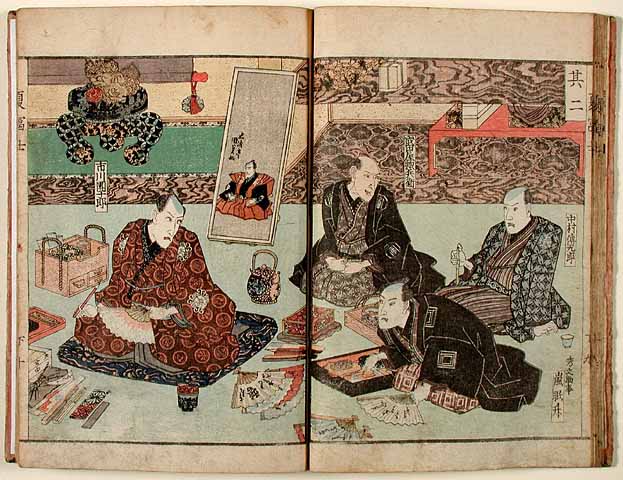
Natsu no Fuji (Fuji in Summer)
2 volumes with colour prints from woodblock, 1827
Private collection
Volume 2
Kunisada 29
Ichikawa Danjuro VII is shown in his sumptuous residence, seated to the left and holding a folding fan on which he is about to inscribe a poem. Fans that he has already inscribed lie at his side.
On the right the actor Araki Minsho applies Danjuro’s personal seal to the inscribed fans. The manager of the Nakamura theatre, Nakamura Denkuro and an assistant manager, Naritaya Sobei, look on. The painting resting against the back wall is of the actor Matsumoto Koshiro V and carries Kunisada’s signature.
The opulence of the fittings and furnishings in Danjuro’s villa contravened the sumptuary laws. Officials turned a blind eye to his lifestyle until 1842, when charges were brought against him, parts of his residence were razed to the ground, and he was exiled from Edo.

Ichikawa Danjuro VII Kunisada 14
Ichikawa Danjuro VII as Sukeroku in Sukeroku yukari no Edo zakura (Sukeroku’s affinity for the cherry blossoms of Edo) performed at the Tamagawa Theatre in 1819; Private collection



